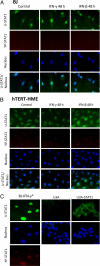Unphosphorylated STAT1 prolongs the expression of interferon-induced immune regulatory genes
- PMID: 19478064
- PMCID: PMC2688000
- DOI: 10.1073/pnas.0903487106
Unphosphorylated STAT1 prolongs the expression of interferon-induced immune regulatory genes
Abstract
In normal human cells treated with interferons (IFNs), the concentration of tyrosine-phosphorylated STAT1 (YP-STAT1), which drives the expression of a large number of genes, increases quickly but then decreases over a period of several hours. Because the STAT1 gene is activated by YP-STAT1, IFNs stimulate a large increase in the concentration of unphosphorylated STAT1 (U-STAT1) that persists for several days. To test the significance of high U-STAT1 expression, we increased its concentration exogenously in the absence of IFN treatment. In response, the expression of many immune regulatory genes (e.g., IFI27, IFI44, OAS, and BST2) was increased. In human fibroblasts or mammary epithelial cells treated with low concentrations of IFN-beta or IFN-gamma, the expression of the same genes increased after 6 h and continued to increase after 48 or 72 h, long after the concentration of YP-STAT1 had returned to basal levels. Consistent with its activity as a transcription factor, most U-STAT1 was present in the nuclei of these cells before IFN treatment, and the fraction in nuclei increased 48 h after treatment with IFN. We conclude that the nuclear U-STAT1 that accumulates in response to IFNs maintains or increases the expression of a subset of IFN-induced genes independently of YP-STAT1, and that many of the induced proteins are involved in immune regulation.
Conflict of interest statement
The authors declare no conflict of interest.
Figures




References
-
- Stark GR, Kerr IM, Williams BR, Silverman RH, Schreiber RD. How cells respond to interferons. Annu Rev Biochem. 1998;67:227–264. - PubMed
-
- Uddin S, et al. Activation of the p38 mitogen-activated protein kinase by type I interferons. J Biol Chem. 1999;274:30127–30131. - PubMed
-
- Qing Y, Stark GR. Alternative activation of STAT1 and STAT3 in response to interferon-γ. J Biol Chem. 2004;279:41679–41685. - PubMed
MeSH terms
Substances
LinkOut - more resources
Full Text Sources
Other Literature Sources
Research Materials
Miscellaneous

